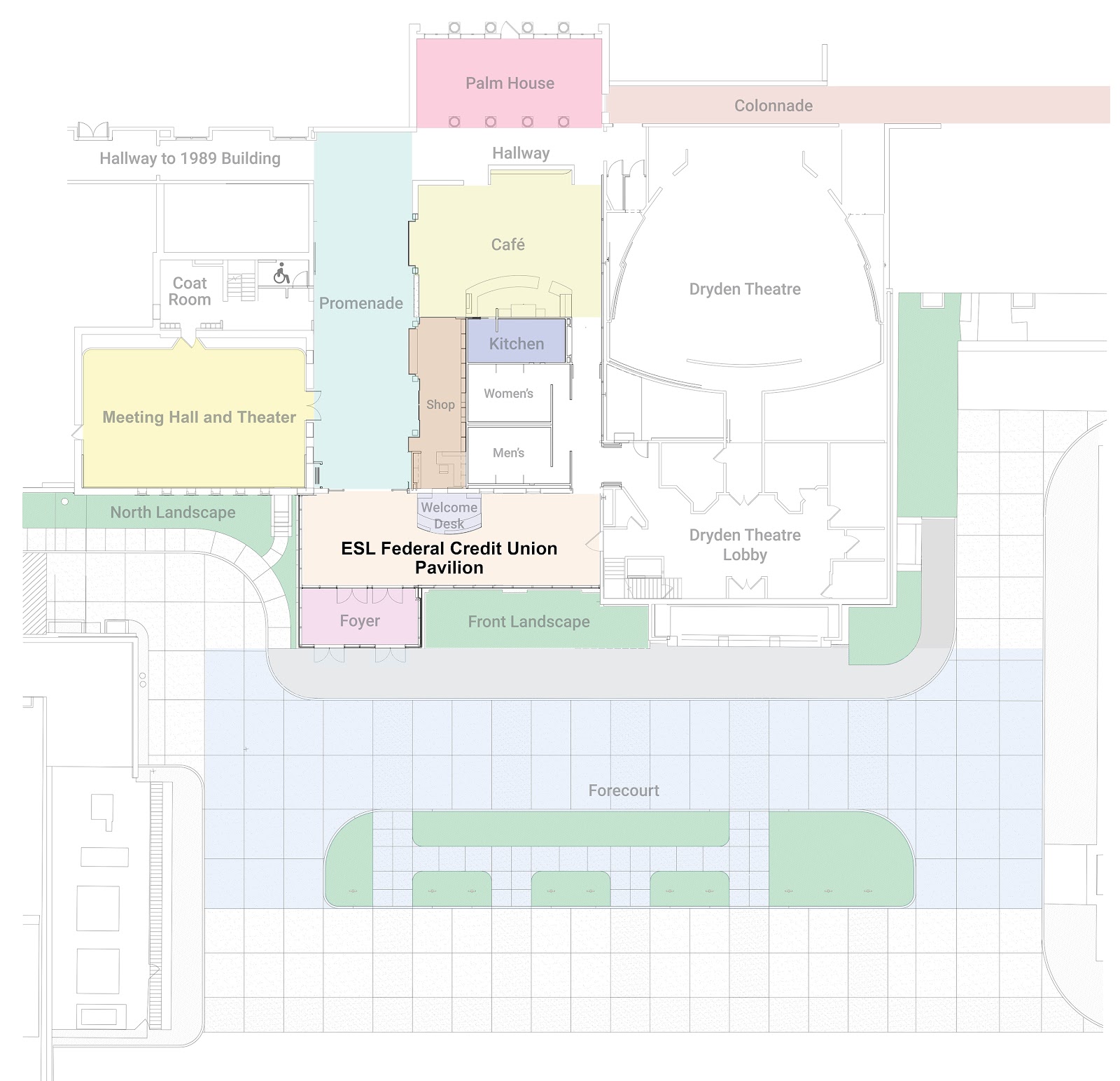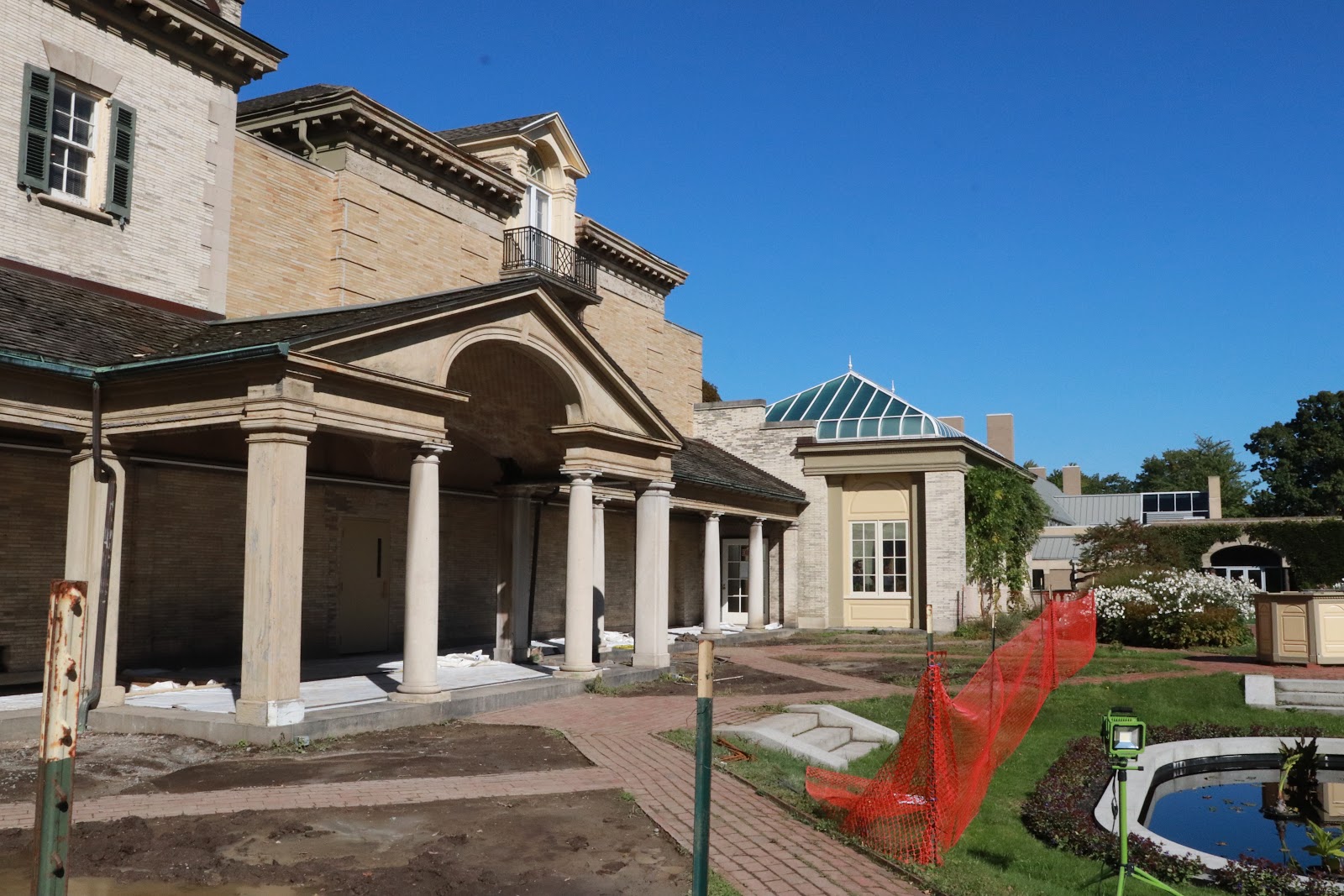
Renderings of the new main entrance of The Eastman Museum.
Image courtesy of The Eastman Museum.
Within the last few months, the Eastman Museum has received two National Endowment for the Humanities (NEH) grants and two Institute for Library and Museum Services (IMLS) grants with a combined total of $1.3 million dollars. The Museum also received $1 million from the New York State Council on the Arts in 2018. These public funds will help implement facilities improvement projects that will create a new accessible main entrance and welcome center as well as restoration work on the historic mansion and gardens— one of Rochester’s National Historic Landmarks. While restoration for the historic Colonnade began this August, construction for the new main entrance and visitor center will begin in January 2020 and is expected to be completed in July 2020.
The Eastman Museum in Rochester, NY was founded in 1947. It is the world’s oldest photography museum and is one of the world’s oldest film archives. A leader in film preservation and photographic conservation, the Eastman houses several million objects in its collection of photographs, film, cinema, photographic and cinematographic technology.
Funding the Visitor Center
“The visitor center project was initiated by a longtime museum patron with a $1.1 million donation, which was matched by a $1 million grant from the New York State Council on the Arts (NYSCA) in conjunction with the Finger Lakes Regional Economic Development Council,” said Kellie Fraver, Public Relations Manager for the Eastman Museum. ESL Federal Credit Union also purchased the naming rights to the new visitor center— the new ESL Federal Credit Union pavilion. In total, over $5 million has been raised so far for the project with another $1 million to complete the capital campaign. The Museum is offering naming rights to the cafe, shop, and foyer to help raise the remaining funds for project completion.
Conceptualizing the Visitor Experience

Interior rendering of the new visitor center. Image courtesy of The Eastman Museum.
The current visitor entrance and gallery spaces were built in 1989. For the past twenty-five years the museum staff have discussed moving that visitor entrance to a more prominent location. This new entrance, new gallery and collection storage building facing University Avenue was originally planned to include a new parking lot that was closer to the entrance. However, due to budget limitations, this parking lot was never built. “The museum’s current main entrance is inconvenient and hard to find for those who arrive by car—the vast majority of our visitors. During inclement weather, getting from one’s car to the main entrance can be unpleasant and potentially hazardous, especially for those with limited mobility,” wrote Bruce Barnes, PhD, Ron and Donna Fielding Director of the Eastman Museum in the Eastman Museum January/February 2019 Bulletin. To improve the visitor experience, new exterior and interior spaces will be reconfigured to be more welcoming, to increase accessible parking, accommodate buses, enlarge and upgrade the cafe, and renovate the Curtis Theatre into a multi-use space.
The 1989 visitor entrance will move near where the current Dryden Theatre location is today, off of the main parking lot. Visitors will enter a glass and steel structure in front of the west facade of the one-story building, originally George Eastman’s garage and where the current museum cafe and shop are located. “The structure is designed to allow the historic facade of the garage to be visible from both within and outside the pavilion,” said Fraver. “Through the new entrance, visitors will be served by a new admissions desk, gathering spaces, a resigned cafe with additional seating in the historic Palm house, and a more misson-focused shop.”
Designed like a promenade, the new entrance will serve as the starting point for visitors into the Eastman Museum. The entrance to the Curtis Theatre, the museum shop, and the expanded cafe will all be designed around this visitor space.
First Impressions

The Eastman Museum relied on visitor engagement data to help with decisions on transforming their own visitor engagement. Survey data from a Culture Track research study “of the changing behaviors of cultural audiences illuminated the length of time it took visitors to experience art at cultural institutions and how that affects their overall experience. The Eastman Museum took a cue from its Kodak history and is transforming an unsightly wall (hiding cooling towers from the HVAC system) to create a “Colorama.” Kodak’s “Colorama” was a large photographic display located on the east balcony inside New York City’s Grand Central Terminal starting in the 1950s to the 1990s that was used to advertise the Eastman Kodak Company. The “Colorama” at the Eastman Museum will feature advertisements for museum programming and events as well as commissioned public art murals. It will be one of the first things seen by museum visitors as they access the new main entrance. The Museum estimates that it will need to raise $375,000 to not only create this dynamic, first impression display, but to establish an endowment to ensure the continuation of its displays.
New first impressions continue inside with interpretive panels that will introduce visitors to the museum. These panels will help illustrate the timeline of George Eastman’s life and the history of photography, including “Snapshot Photography” that will allow visitors to see themselves in the history of photography. With all of these new changes, there are also discussions on what these new spaces will mean for their interpretative plan which asks:
-
What should the visitor experience first inside the museum?
-
Should they tour the hour first or explore the gallery space?
-
How do we animate the gallery space?
-
Is this where the tour ends?
These questions and others are being asked as the museum looks to what comes during and after these major capital improvement projects to their facilities. Beyond creating a more welcoming visitor entrance and more dynamic spaces, how the visitor will interact past the admissions desk in its new space, is a critical next step and an opportunity for the Eastman Museum to re-evaluate its interpretative strategy. The Eastman Museum plans to apply for another IMLS grant to create a new entrance into the historic house through the kitchen rather than the dining room. “It’s where George Eastman’s kitchen was [the new entrance to the house] because what we would like to do… the whole photography for George Eastman started in his mother’s kitchen in his boyhood home. So how perfect to have something where you start in the kitchen to tell the story,” said Eliza Kozlowski, Director of Marketing and Engagement at the Eastman Museum. “You’re in the kitchen and this is where it all began.”

Visitors entering through the conservatory during the temporary construction route of the Colonnade.
New Spaces and Staffing
This project will also transform theatre spaces like the Curtis into multi-function spaces by exposing the original carriage house windows and moving the entrance tohave easy access from the new promenade in the new visitor center. Blackout curtains and a drop-down screen will still allow this space to be used as a theater while also creating a new space for other programming and events.
The museum store is expected to reduce its size to around 400 square feet. Inventory has already been reduced and the museum will focus on selling items unique to the Eastman Museum–branding, photographers, Rochester based items, etc. rather than generic gifts.
The new location of the admissions desk will have the museum store office located behind, creating an opportunity for some shared staffing. The museum already has four staff members that were originally part of the contract guard service but are now employed by the museum to serve as “guard/hosts” and the museum ideally would like to create more multi-role positions.

New main entrance and visitor center plan. Image courtesy of The Eastman Museum.
Messaging and Marketing
“At one point we had this tagline that was ‘opening new doors’ that we wanted to have as part of this project but once it became this bigger visitor center we had to rethink that tagline,” said Kozlowski. “Our challenge with the messaging is not over-promising in that we’re saying transforming ‘our visitor experience’ rather than transforming ‘the visitor experience’ because the rest of the experience is not going to be very different it’s the idea that being more welcoming, being more accessible the whole cafe, store, the new experience there...a new interpretive panel as an introduction to the museum...so were rethinking the map as far as how we position what the visitor will experience first,” said Kozlowski.
The Eastman Museum has already released the initial announcement with renderings of the visitor center as well as introducing project signage throughout the museum. Additional promotion will be included in the museums’ e-newsletter and social media channels and will grow closer to January 2020 when the project will officially begin. Media announcements will be made as the project progresses until the mid-July ribbon cutting.

Kathleen Connor, Curator, George Eastman Legacy Collection, with museum signage regarding the restoration and preservation work.
Other signage regarding the restoration and preservation work of the historic mansion can be found throughout helping to guide visitors through temporary routes (calling them “construction detours”) but also educating the public about what kind of work is happening and its significance. Signs encourage further information available on the museum website.

“Construction Detour” sign for the new route into the historic mansion.
Restoration Priorities
Originally, the new visitor entrance was going to begin this year, but the museum was happy to delay in favor of critical restoration projects for the historic house. The historic Eastman mansion received two federal grants. The first was a Save America’s Treasures grants of nearly $500,000 for the restoration of the Colonnade of George Eastman’s mansion which began this past summer. This project will continue to transform the visitor experience into the historic house as the Colonnade is the only interior route between the museum’s main entrance and galleries and the historic mansion and Terrace Garden.

Historic Colonnade during construction.
Because of this massive project, the Colonnade was closed, re-routing visitors outside through the Terrace Garden and entering the historic mansion through the conservatory. The Dryden Theatre was also closed as the Colonnade serves as a path of egress for two emergency exits from the theatre.

Historic Colonnade under restoration.
But this project was not only to help the deteriorating floor structure of the Colonnade but to create a more comfortable visitor experience year-round with a new insulated glass system and a new heating and cooling system.
It is the largest project in the ongoing restoration. “Restoration has been completed on the Palm House, the Porte-cochere, the conservatory roof and clerestory windows, the North Organ, and the East Porch. The next project will be the restoration of 68 windows in the mansion. The Eastman Museum is currently applying for a grant from the New York State Parks, Recreation and Historic Preservation for the restoration of the historic garden structures—the pergola in the Terrace Garden, the Grape Arbor in the Rock Garden, and the loggia in the West Garden,” said Kellie Fraver.
The new main entrance and visitor center will help to transform the visitor experience at the Eastman Museum. These projects will make the Eastman Museum “a more welcoming museum” as Executive Director Barnes remarked. Support from State and Federal funding demonstrate commitment to improving the visitor experience as well as d the economic and social impact that museums like the Eastman contribute to their communities.
Further Reading / Resources
Director’s Note: Grants Enable Major Projects
https://medium.com/george-eastman-museum/directors-note-grants-enable-major-projects-22921bac0da8
Restoration & Construction
https://www.eastman.org/restoration-construction
New Visitor Center
https://www.eastman.org/new-visitor-center
IMLS “Save America’s Treasures” Grant Funding
https://www.imls.gov/grants/available/save-americas-treasures
